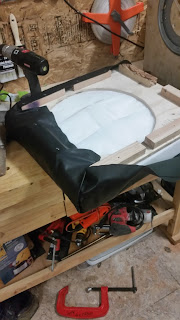- We connected our device to the voltmeter and a battery, then we turned on our device to measure the current used by our system. During the experiment, the motor used up to 6 amps current. The picture below shows the experimental setup:
- Next, we added the Teflon on the device.
- We first added the Teflon to each ridge as it is shown in the pictures below:
- Then after, we covered the whole top part of the device by the Teflon. Staples were used to attach the Teflon on the device. The pictures below show how it was done:
A access point needed to be made for the cables of the motor as shown bellow:
Once the access point was made the synthetic leather was attached around the top layer of the device with the cushion within it as shown bellow:
The base layer was then used to have the synthetic leather attached on the sides of the base as shown bellow:
Furthermore, Velcro was attached to the top layer and base layer of the device. This served the purpose to attach both components and have the ability to easily show the components within the device if needed. This process is shown bellow:
The finalized product is shown in the picture bellow:





























